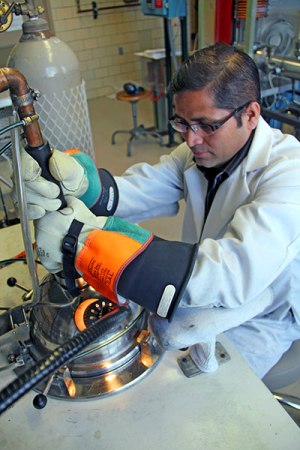Apr 25 2015
Karl A. Gschneidner and fellow scientists at the U.S. Department of Energy’s Ames Laboratory have created a new magnetic alloy that is an alternative to traditional rare-earth permanent magnets.
 Scientist Arjun Pathak arc melts material in preparation for producing a new type of magnet.
Scientist Arjun Pathak arc melts material in preparation for producing a new type of magnet.
The new alloy—a potential replacement for high-performance permanent magnets found in automobile engines and wind turbines--eliminates the use of one of the scarcest and costliest rare earth elements, dysprosium, and instead uses cerium, the most abundant rare earth.
The result, an alloy of neodymium, iron and boron co-doped with cerium and cobalt, is a less expensive material with properties that are competitive with traditional sintered magnets containing dysprosium.
Experiments performed at Ames Laboratory by post-doctoral researcher Arjun Pathak, and Mahmud Khan (now at Miami University) demonstrated that the cerium-containing alloy’s intrinsic coercivity—the ability of a magnetic material to resist demagnetization—far exceeds that of dysprosium-containing magnets at high temperatures. The materials are at least 20 to 40 percent cheaper than the dysprosium-containing magnets.
“This is quite exciting result; we found that this material works better than anything out there at temperatures above 150° C,” said Gschneidner. “It’s an important consideration for high-temperature applications.”
Previous attempts to use cerium in rare-earth magnets failed because it reduces the Curie temperature—the temperature above which an alloy loses its permanent magnet properties. But the research team discovered that co-doping with cobalt allowed them to substitute cerium for dysprosium without losing desired magnetic properties.
Finding a comparable substitute material is key to reducing manufacturing reliance on dysprosium; the current demand for it far outpaces mining and recycling sources for it.
The paper, “Cerium: An Unlikely Replacement of Dysprosium in High Performance Nd-Fe-B Permanent Magnets” was published in Advanced Materials, and co-authored by Arjun K. Pathak, Mahmud Khan, Karl. A. Gschneidner, Ralph W. McCallum, Lin Zhou, Kewei Sun, Kevin W. Dennis, Matthew J. Kramer and Vitalij Pecharsky of the Ames Laboratory; Chen Zhou of MEDA Engineering and Technical Services LLC; and Frederik E. Pinkerton of General Motors R&D Center.
The research was supported by the U.S. Department of Energy’s ARPA-E REACT program (Advanced Research Projects Agency-Energy–Rare Earth Alternatives in Critical Technologies) which develops cost-effective alternatives to rare earths, the naturally occurring minerals with unique magnetic properties that are used in electric vehicle (EV) motors, and wind generators. The REACT projects identify low-cost and abundant replacement materials for rare earths while encouraging existing technologies to use them more efficiently.
Ames Laboratory is a U.S. Department of Energy Office of Science national laboratory operated by Iowa State University. Ames Laboratory creates innovative materials, technologies and energy solutions. We use our expertise, unique capabilities and interdisciplinary collaborations to solve global problems. DOE’s Office of Science is the single largest supporter of basic research in the physical sciences in the United States, and is working to address some of the most pressing challenges of our time. For more information, please visit science.energy.gov.